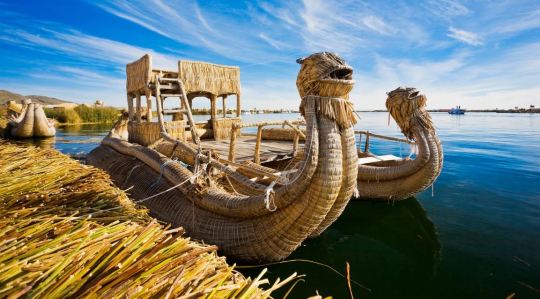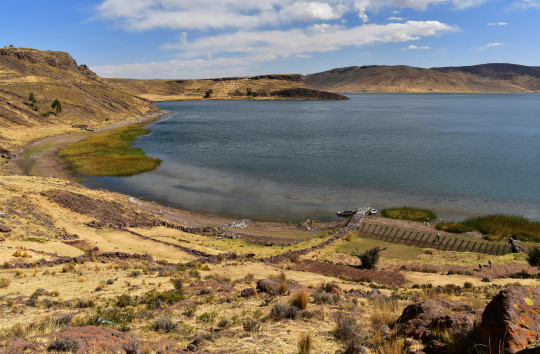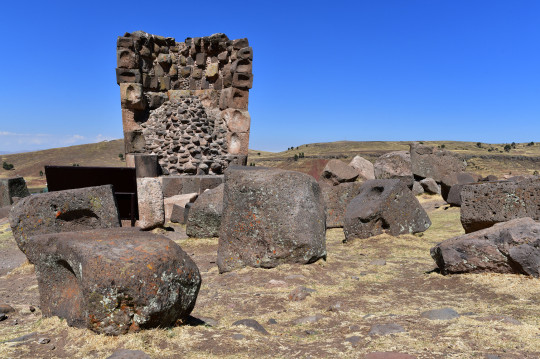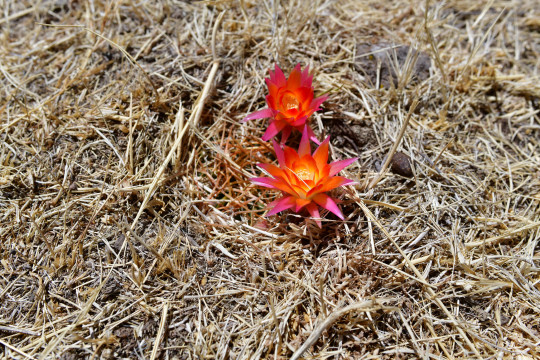#Sillustani
Explore tagged Tumblr posts
Text

The fairytale-like Uros Islands are made entirely from totora reeds; the lives of the inhabitants of these artificial islands are entirely dependent upon the reed beds they live among.
#cuscojourneys#infomachupicchu#perutreks#incatrail#urosisland#floatingislands#urosislands#puno#islasflotantes#Peru#southamerica#backpackersouthamerica#backpackingtips#titicacalake#titicaca#amantani#sillustani#wanderlust#globetrotter#backpackers#picoftheday#smiling#natgeo#igerspuno#perutravel#discoverperu
7 notes
·
View notes
Text

Sillustani, Puno
0 notes
Text






chullpas (funerary towers)
Sillustani, Lago Umayo, near Puno, Peru (2018)
© optikestrav
0 notes
Text

"Chullpas", Sillustani located near Puno (Peru), near Lake Titicaca.
7 notes
·
View notes
Text




Umayo and Sillustani (2) (3) (4) by Panegyrics of Granovetter
Via Flickr:
(1) Animals graze near a quiet dock below Sillustani. (2) Sillustani ruins. (3) Chullpa guts at Sillustani. (4) Bright flowers in the dead grass at Sillustani.
2 notes
·
View notes
Text
The Enigmatic Towers of Sillustani
Although located outside of Cusco, Sillustani is one of the most fascinating pre-Inka and Inka archaeological sites in the region. This site is famous for its chullpas—massive funerary towers built by the Colla civilization and later adopted by the Inkas. These cylindrical structures were used to bury elite members of society, symbolizing their journey to the afterlife.
Perched on a hill overlooking Lake Umayo, Sillustani offers breathtaking views that add to its mystical atmosphere.
With Magical Cusco Travel, visitors can explore these impressive towers, learn about ancient Andean burial practices, and experience the spiritual energy that lingers in this sacred place.
0 notes
Text
Puno: The Gateway to the Andes and Inca Culture
Although not located directly in Cusco, Puno offers a unique opportunity to explore the cultural richness of the Andean region. Puno, situated on the shores of Lake Titicaca, is known for its close connection to Inca and pre-Inca cultures. The region features a number of important archaeological sites, including the ancient burial sites of Sillustani and the floating islands of the Uros people.
Puno’s proximity to both the Sacred Valley and Machu Picchu makes it an ideal stop for those wishing to extend their exploration of Inca heritage.
Visitors can learn about the region’s history, folklore, and traditions, experiencing the continuity of Inca culture in the modern day. Andean Peru Discover offers tours in Puno, guiding travelers to important historical sites and sharing the fascinating stories of the Andean people.
0 notes
Text
Lake Titicaca: Exploring the Highest Navigable Lake in the World
Stretching across the border of Peru and Bolivia, Lake Titicaca is the highest navigable lake in the world and a place of deep cultural and spiritual significance for Andean civilizations. This vast body of water is home to the Uros floating islands, handmade from totora reeds, and the traditional communities of Taquile and Amantaní, where ancient customs and traditions are still alive.
With Andean Peru Discover, travelers can take a boat journey across the lake, meet the indigenous communities who have lived here for centuries, and learn about their unique way of life. Visitors can also explore the pre-Inca ruins of Sillustani, where mysterious chullpas (funeral towers) rise above the landscape, offering a glimpse into the region’s ancient past.
A visit to Lake Titicaca is more than just a scenic escape—it’s a deep dive into the rich cultural heritage of the Andes.
0 notes
Text
More that 25 rivers empty their waters into Titicaca; the largest, the Ramis, draining about two-fifths of the entire Titicaca Basin, enters the north-western corner of the lake. One small river, the Desaguadero, drains the lake at its southern end. This single outlet empties only 5 percent of the lake's excess water; the rest is lost by evaporation under the fierce sun and strong winds of the dry Altiplano.
There is evidence off the continuous presence of human population in the lake's area: the monumental remains and both tangible an intangible elements talk about different settings, the land-use and its management through specific and outstanding cultural manifestations. This evidence shows the constant relation between man and nature since ancient days and during a long period of time that goes from the birth and development of Andean pre-Hispanic societies until our days.
This long process that began approximately around 10 000 b.c. to 8 000 b.c. and lasted until the first third of the sixteen century with the arrival of the Incas was characterized by different and successive Andean societies and ethnic groups. The other period comprises from Colonial times in the sixteenth century up to our days. All this process has defined a cultural area where tradition has been preserved showing the permanence of ways of life, of customs and ancestral values.
Archeological architectonic building of great singularity in some sites as Pukara, Sillustani, Cutimbo (Peruvian side) and Tiwanaku and the Isla del Sol (Bolivian side) are clear evidence of the existence of societies such as Pukara, Tiwanaku, Colla Lupaka and Inca.
instagram
0 notes
Photo

Funeral towers of Sillustani, Peru - https://storelatina.com/?p=2627
0 notes
Photo

Chullpa of Sillustani, on the shores of Laguna Umayo, Peru. October 2016.
17 notes
·
View notes
Photo



Sillustani, complejo funerario de la cultura Kolla
5 notes
·
View notes
Text
Peru Gezilecek Yerler
Peru, gezginler için çok çeşitli olasılıklara sahip bir tarih, kültür, güzellik ve macera ülkesidir. Machu Picchu’nun antik İnka Şehri, Güney Amerika’ya yapılan herhangi bir gezinin en önemli noktalarından biridir, ancak Peru’da keşfedilecek çok şey var. Dünyanın en yüksek gezilebilir gölünde bir tekne turuna çıkabilir, dünyanın en derin kanyonlarından birine bakabilir, kum tepelerinde kum sörfü…

View On WordPress
#Arequipa&039;s Historical City Center#Barranco#Cañon del Colca#Colca Canyon#Cusco&039;s Architectural Treasures#Huacachina&039;daki Ica ve Kum Tepeleri#Lake Titicaca#Lima&039;s Historic Center#Machu Picchu#Nazca Lines#Peru Gezilecek Yerler#peru turistik yerler#Pisco ve Ballestas Adaları#Puerto Maldonado and the Amazon#Sillustani#The Inca Trail#The Sacred Valley
1 note
·
View note
Text




Umayo and Sillustani (2) (3) (4) by Panegyrics of Granovetter
Via Flickr:
(1) The village of San Antonio on the shores of Lake Umayo. (2) Pre-Inca remains at the archaeological site of Sillustani. (3) Andean Flicker. (4) Reed architecture.
0 notes
Photo





Chullpa’s, (burial towers) Sillustani, Peru. Believed to have been built by the pre Incan, Qualla People.
138 notes
·
View notes
Text
Puno: Planning a Journey to the Altiplano
Known as the folk capital of Peru, Puno is also mainly known by travelers for Titicaca Lake, the highest navigable lake in the world. This region was originally occupied by the Pucara and Tiahuanaco civilizations more than 1000 years ago, and it is believed that the founders of the Inca civilization came from this area after the decline of the Tiahuanacos. Puno is also a multicultural region where locals speak Spanish and/or Quechua or Aymara, and their customs and beliefs are a mix of the Andean way of living practiced by early Peruvians and the Catholic practices implemented by the Spaniards.
Lake Titicaca, undeniably the most popular attraction of Puno among travelers, can offer a truly amazing experience. Several communities have inhabited the area around the lake and even in the lake for hundreds of years, and their customs have barely changed. A standard visit to the lake will take travelers to the artificial Uros Islands, were locals have been constructing the islands with the Totora plant (a subspecies of the giant bulrush sedge) for at least 500 years. This one-day tour also allows travelers to visit Taquile Island, where natives welcome visitors and give demonstrations of their ancient practices and way of living. One of their main activities is weaving. Men play an important role in this task, and their clothing tells people who they are in their community.
The standard visit is the most common activity around the lake; however, there are other activities which offer a richer experience. For instance, the people of the Taquile, Amantani, and Uros Islands have prepared basic accommodations to welcome travelers who want to spend the night on the islands. In addition to learning more about the native customs, these travelers get to experience incredible sunsets and sunrises. In addition to these three islands, Suasi Island can offer a superb experience for travelers looking for more comfortable accommodations. The hotel there offers an all-inclusive three-day package for visiting the island and also relaxing in a unique location.
“La Virgen de la Candelaria,” the most interesting and entertaining Andean festival in Peru, takes place in February every year. This celebration congregates hundreds of colorfully costumed dancers and musicians, who energetically perform in the streets of Puno. Their music and dances, having evolved over time, are an artful expression of the syncretism of Quechua, Aymara, and Catholic traditions.
The traditions and customs of the locals are the product of ancient civilizations as well as the harsh environment itself, where humans, plants, and animals have had to adapt to the rugged terrain with its low temperatures and high elevation. The ancient Peruvians who settled in this area left behind the archaeological sites of Pucara and Sillustani. These sites offer important information about their customs and practices. The Pucara people developed an important civilization around 200 BC, building an impressive administrative center where several monoliths representing humans and animals, such as snakes, frogs, pumas, and fish, have been found. Later on, the Tiahuanaco emerged near La Paz in Bolivia and extended their domain to the region of Puno and other regions of southern Peru. At the archaeological site of Sillustani, travelers can observe the remains of tombs built by the Tiahuanacos, Collas, and Incas. This site is located next to Umayo Lake, where Andean flamingo inhabit during the warmer months of the year (mid-October to mid-April).
A visit to Puno should be carefully planned due to its high elevation. It is highly recommended that travelers first visit a lower-elevation region such as Arequipa or Cusco to get acclimated before spending time in Puno. When visiting the region, travelers should stay near the downtown or around the lake. Staying downtown allows travelers to experience the local way of living with several options to enjoy Peruvian food while observing local music and dance performances. Staying close to the lake allows travelers to relax at one of the secluded hotels in that area.
youtube
By Renato Romero - Founder of My Peru Guide LLC
#puno#laketiticaca#lake titicaca#punotravel#punotours#punotour#sillustani#sillustanipuno#pucara#pucarapuno
2 notes
·
View notes